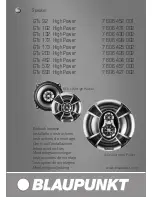
X
-
T
R
E
M
E
user’s guide
X
-TREME
via Monti Urali, 31 - 42029 Reggio Emilia (Italy)
●
tel.+39 0522 557735
●
fax.+39 0522 393733
●
e-mail: [email protected]
Stacking Guidelines.
The designer need to know if the audience is
standing or seated; if used in flown system
the bottom of the array or cluster should
always be higher than the ears of the first
rows of the audience. If the bottom of the
array is too low, the first rows receive too
much
SPL and audience members directly in
front of the system behave as an acoustic
screen for the following rows.
Subwoofers.
Subwoofers are used to extend the frequency
response of the “full range” base system
XTQ12
,
XTQ15
,
XTQ300
down to 35 Hz and
to increase the overall SPL without increasing
the potential for audience hearing loss.
General guidelines for the use of
subwoofers.
The number of subwoofers to be used
depends on 3 parameters.
1) Number of XTQ12
,
XTQ15
o
XTQ300
elements.
The standard recommended number of
XTQS15
or
XTQS18
subwoofers corresponds
to
1:1
ratio (see XTQ12 + XTSQ15, XTQ15
+XTSQ18 or XTSQ15 configurat-
ions).
2) Type of musical event to reproduce.
Standard subwoofer ratios are recommended
for classical music or corporate events. For
those applications, subwoofers act as a
low frequency extension for base systems
and provide approximately 6 dB of low
frequency contour. In this case, the overall
system behaves as an extended bandwidth
3-way system in biamplification.
For live applications with rock music sound
reinforcement, the
configuration
with
XTQ12
and
XTQ15
and with two
XTSQ15
o
XTSQ18
subwoofers
can be
used
.
3) Location or installation types.
In outdoor applications, when subwoofers are
located on the ground,
the ratio remains
unchanged.
Amplification.
Modular Line
loudspeakers are designed to
be used with professional power amplifiers,
able to produce the following output power:
XTQ300
XTQ12
XTQ15
XTSQ15
XTSQ18
full range: 500 W (@ 8 Ohm)
full range: 450 W (@ 8 Ohm)
full range: 600 W (@ 8 Ohm)
subwoofer: 1000 W (@ 8 Ohm)
subwoofer: 1000 W (@ 8 Ohm)
Particular attention will have to be paid to
avoid amplifier clipping. It is important
to underscore that a sub-dimensioned power
amplifier could
easily reach clipping,
particularly damaging phenomenon, whether
for acoustic and psychoacoustic reasons or
for electronic causes. In musical field, we
must underline that signals have a high
dynamic content and a power amplifier could
operate in saturation region, just introducing
signal clipping, or rather a non linear signal
distortion. In those
conditions, power amplifier
will produce more power in comparison with
nominal undistorted condition. The use of
power amplifier with output power higher than
the recommended output power is unsuitable,
too. We have also to avoid in electronic
devices switching bursts, that could cause
instantaneous peaks higher than the
loudspeaker instantaneous power.





























